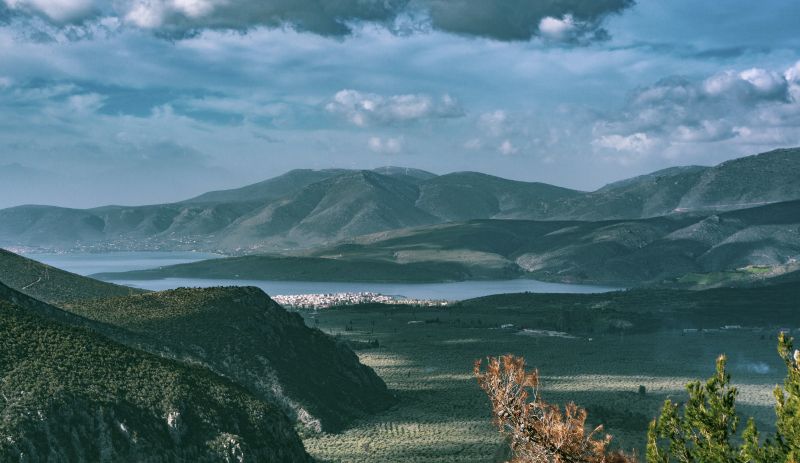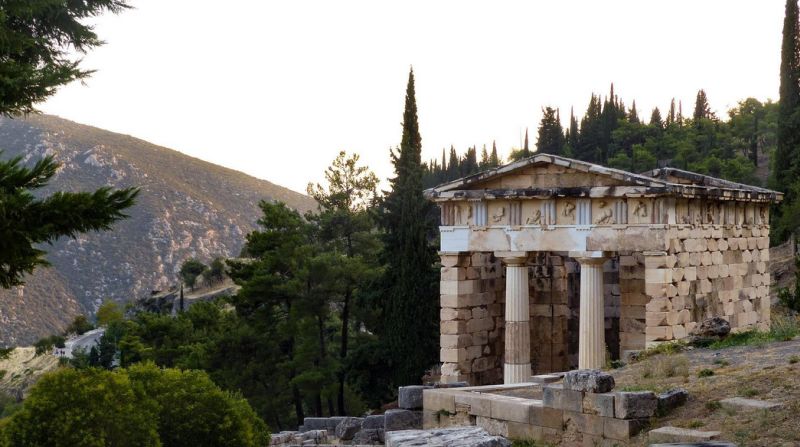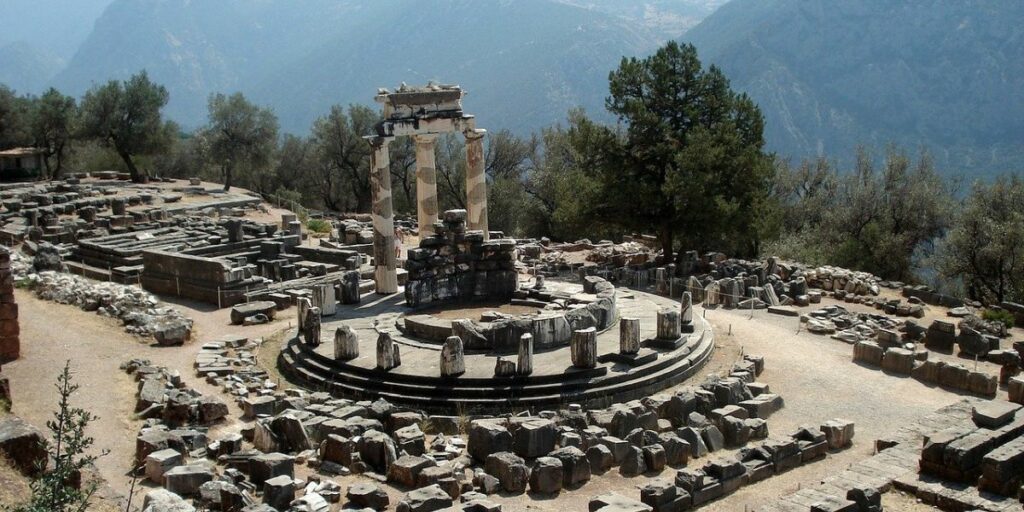Dear Traveler,
As you choose your next path, looking for meaningful and transforming journeys, a place of deep mystery and astounding beauty might call for you from the heart of Greece.
And should you follow its siren call to the rocky slopes of Mount Parnassus, you will find yourself reverently walking the grounds of Delphi’s Ancient Sanctuary. A site that is said to grant wisdom and inspiration to its wanderers, should they visit it with an open mind, and uplift their spirit with its other-worldly loveliness.
Perched in a magnificent place, both ancient and modern Delphi overlook breath-taking sights of dramatic cliffs and sublime olive groves, gradually tumbling into the Ionian Sea, by the Gulf of Corinth.
You have traveled to a magical site, Dear Traveler. A place of stunning scenery, captivating archeological artifacts, inspiring ancient wisdom, and ennobling cultural festivals.
And if you are looking for even more reasons to celebrate your choice of destination, Delphi and the surrounding area offer you a chance to explore some authentic Greek villages, famous for their delectable cuisine and hospitality. Embarking on Greece tours, for example, ensures an enriching experience, introducing travelers to these hidden gems and ensuring they get the most out of their visit to this historic region.
Stay with me Dear Traveler, to discover more about magnetic Delphi and its uplifting magic!
History and Legends
Welcome to the realm of Apollo, the Olympian God of Light, Knowledge, and Harmony!
Once home to sacred Pythia, the God’s famous Oracle, it was considered the Navel of the World in ancient times, and it was sought by people from far and wide, both great rulers and ordinary folk, looking to find knowledge, guidance, and partake in its legendary riches and festivals.

The Legend
Myths speak of the day the great God Zeus sought to find the Navel of the World. He sent two eagles, one from the East, one from the West, and as they crossed paths over the future site of Delphi, the Great Father raised the Omphalos Stone there to mark it.
Gaia, ancient Mother Earth, was worshiped here first, her temples long lost in mists and mysteries.
As Apollo chose this place for his Oracle, legends say he slew Gaia’s child, the Great Serpent Python, who was guarding the Navel, claiming Delphi for himself.
The Story
Raised around the 8th century B.C., by a colony of priests from the Isle of Crete, Apollo’s Sanctuary quickly became one of the most important holy places in Antiquity.
So famed was Delphi’s Oracle, that rulers from every corner of the ancient world came here to worship the God of Light and Harmony and to ask for guidance before momentous decisions.
A sanctuary for all, not controlled by any state, Delphi became a symbol of elevation, wisdom, and unity. A place to gather as brothers, seek knowledge and celebrate common ennobling values. And for almost a thousand years, it remained so.
During this time, the sanctuary endured many hardships, withstanding both natural catastrophes and control attempts. As greed for power drove some of the ancient rulers to claim it as their own or pillage it, Delphi managed to survive, true to its values, being reborn again and again, as a haven for knowledge and unifying ideas.
Eventually, as nothing lasts forever, with the rise of Christianity, Delphi’s magnificence was lost to the turmoil of changing times. Around 393 A.D, the Byzantine emperor Theodosius banned the practice of ancient religions and the Pythian Games, held every four years at the sanctuary. At that point, many of its temples and glorious statues were destroyed or buried and forgotten.
The legendary place was rediscovered during the 1890s when Athens’ French School of Archeology was granted the right to excavate the site. As the mythical sanctuary was buried deep under the village of Kastri, they had to relocate the entire community before unraveling its magnificent ruins and artifacts.
Today, once again, Delphi’s sacred path is walked by thousands of pilgrims and tourists, looking to capture some of its past splendor and uncover its mysteries.
7 Unforgettable Experiences in and around Delphi
1. Discover the Wonders in Delphi’s Archaeological Museum
Considered one of the most important museums in Greece and home to the countless treasures uncovered at Apollo’s Sanctuary, Delphi’s Archaeological Museum is an awesome way to start your visit.
As the amazing artifacts tell the story of the ancient sacred place, from the Mycenaean era to the Greco-Roman times, offering glimpses of Delphi’s past magnificence, they prepare each visitor to walk the paths of the Sanctuary with understanding and awe, capturing the essence and meaning of each encountered marvel of the Archeological Site.
Among the most precious artifacts nestled in the museum’s 14 rooms, you will find the famous Charioteer of Delphi, the Chryselephantine (gold and ivory) statues depicting Apollo and Artemis, the large Sphinx of Naxos, and the famed kylix (drinking cup) portraying the seated Apollo holding his lyre.
The museum also shelters two of the oldest written notations of a melody – the carved hymns to Apollo – discovered at the Sanctuary’s Athenian Treasury, and an ancient copy of the sacred Omphalos Stone.

2. Explore the awe-inspiring Archeological Site
As you leave the museum, your mind soaring with the images of Delphi’s past splendor and its breath-taking masterpieces, your feet will reverently guide you to the grounds of the sanctuary, eager to walk the sacred paths and discover more of its mysteries.
The Sanctuary of Athena Pronaia
As the ancient truth seekers so long ago, you will first stop at the Sanctuary of Athena Pronaia, “Athena who is before the Temple” or “Athena of Forethought”. Half-sister and protector of Apollo, the Goddess guarded his sanctuary, her temples standing at the gateway to Delphi.
Here is where you’ll find one of the most beautiful and mysterious buildings in Delphi, the Tholos. The impressive circular building, whose purpose remains hidden, is considered one of the architectural wonders of the world, due to its expertly calculated ratios, based on the golden number. Three of the almost 6-meter-tall exterior columns are still standing, giving each visitor a sense of its past gloriousness and making it one of the most famous landmarks in Delphi.
Amidst the other impressive structures to be found in this part of the sanctuary, an interesting construction stands out. Built during the 4th century B.C. the Gymnasium was intended as a training area for athletes and a site for education, lectures, and cultural events. The large block of buildings included, among other wonders, a covered training area for bad weather on its upper side and a circular pool, ten meters in diameter and two meters deep, filled with hot water during the Roman era. Though it can’t yet be visited, the site is visible from the road near Athena’s Sanctuary.
The Sacred Way
Having passed through the gateway of Delphi, you now find yourself on the winding Sacred Way leading up to the Temple of Apollo.
In ancient times this glorious path was lined with impressive monuments, statues, and treasuries, built to honor Apollo and thank the Oracle for her advice. These structures were also raised to hold the many offerings to the god, and, of course, illustrate the power and wealth of the city that had built them.
Among the most famous such buildings is the Athenian Treasury, situated right below the Temple of Apollo. Reconstructed during the 1900s it was initially built around 490 B.C., most probably after the famous battle of Marathon.
Another fascinating segment of the Sacred Way is the Polygonal Wall, at the back of the Athenian Gallery or Stoa, dedicated by the powerful city-state after their victory in the Persian Wars. The wall, built to support the terrace for the Temple of Apollo, carries almost a thousand release contracts for slaves carved on its stones, their freedom granted under the protection of the Olympian God, and as such, inviolable.
Between the Athenian Treasury and the Stoa, you can glimpse the famous Sybil Stone, a legendary terrace-like rock, from where it is said an earlier Oracle of the Mother Goddess prophesized the Trojan War.
The Temple of Apollo
After following the Sacred Way up its winding path, you will reach the heart of Delphi, the celebrated Temple of Apollo.
Here is where thousands of people would wait their turn to plead for the Oracle’s guidance, pondering on the right question to ask and the impact Pythia’s answer would have upon their life.
Above the entrance to the Temple, they glimpsed the most famous Delphi Maxim: “Know thyself“, carved along with two others – “Nothing in excess” and “Surety brings ruin”. Though considered the most important, these were but three of the 147 Maxims carved on the Temple of Apollo, instructing its visitors on how to live a moral life, guided by wisdom.
The revered Pythia delivered her prophecies in a secluded room at the back of the Temple, called the Adyton. Here she sat on a tripod above a fissure in the rock, from whence legends say sweet vapors arose out of the body of the slain Python, inducing the sacred trance that allowed her to become a vessel for Apollo.
The captivating ruins to be found here today still manage to inspire reverence and awe to their wanderers, bringing monumental questions to their minds and reminding them to always seek wisdom, within and without.
Delphi’s Ancient Theatre and Stadium
Above the Temple, two more beautiful buildings await their discovery. The well-preserved Theatre and Stadium were the main arena for the famous Pythian Games, held here every four years in honor of Apollo and his Oracle.
The major event, considered second only to the Olympics, would summon here the entire Greek world to participate in its various competitions. Unlike their more famous counterpart, the Pythian Games included, alongside athletic competitions, music, dance, and art contests. They also allowed women to compete in some of the events.
The Theater, built to entertain around five thousand people, was also periodically used for dramatic plays, poetry readings, and musical events.
3. Go on a Hike to the ancient Corycian Cave
If you are looking for further mysterious and stimulating sites to wander around, you don’t have to search very far. About 11 kilometers north of Delphi, hidden deep in the fir forests of Mount Parnassus, another intriguing sacred place welcomes the curious adventurer.
Rumored to be a magical spot, a dwelling of the nymphs, the wild god Pan and the mysterious Dionysus, the Corycian Cave is a natural sanctuary, where ancient gods were worshiped ever since the Neolithic Era.
Plus, many inscriptions and artifacts discovered at the cave, have shown that it was another site of divination, if at a much lower scale than Delphi.
Even though it is possible to get fairly close to the cave by car, a 4×4 being recommended for the steep dirt road, most wanderers choose the 20 km hike there and back, for its beautiful sights and tranquility. The moderately challenging hike starts in Delphi and takes about 8 hours to complete. Whichever way you choose, do remember to pack a headlight for exploring the cave.
4. Visit the Museum of Delphic Festivals
Luring any culture enthusiast with its fascinating story and intriguing items, the Museum of Delphic Festivals is another enchanting little gem waiting to be discovered next to the Ancient Sanctuary.
In 1927 and 1930 the famous Greek poet Angelos Sikelianos and his American wife, Eva Palmer-Sikelianos, managed to sublimely recreate the ancient Delphic Festivals, bringing together scholars and artists from all over the world.
The two memorable events included performances of ancient plays at the Sanctuary’s Theatre and athletic competitions in its Stadium, intertwined with Byzantine music concerts, conferences, and Folklore exhibitions, in a superb effort to connect the ancient and modern faces of Delphi. Unfortunately, huge costs and lack of financial support prevented the Sikelianoses from renewing the Festival for a third edition.
The museum, housed in their charming former residence, recounts the couple’s mesmerizing story and displays items from the two Festivals, including costumes, photographs, manuscripts of the poet, and many personal items.
5. Attend the New Delphic Games
Following the Sikelianoses’ dream of recreating the ancient Festival, members of the Isadora Duncan International Institute and Harvard University’s Center for Hellenic Studies, together with the local municipality and many important contemporary artists and scholars, developed the extraordinary “New Delphic Games“.
For five days, between the 22nd and the 28th of May 2022, you have the chance to attend mind-opening conferences, workshops, and world-class artistic performances in a Festival that aims to bring music, dance, poetry, theater, philosophy, and sports back to the legendary Sanctuary.
The Festival includes guided visits to all the important sites in the area, offering you a complete and unique way of discovering Delphi, and a chance to experience its international and atemporal nature, in an extraordinary event that aims to recapture “the Delphic Spirit”.
For more information and registration options, please check out the New Delphic Games’ website.
6. Enjoy the Appetizing Local Dishes
 There is a great joy for us wanderers in discovering each new place’s culinary treasures, along with the cultural and natural ones. And Delphi will definitely charm you with its delicious local products and specialties, served with good humor and warm hospitality in each Tavern and grocery store.
There is a great joy for us wanderers in discovering each new place’s culinary treasures, along with the cultural and natural ones. And Delphi will definitely charm you with its delicious local products and specialties, served with good humor and warm hospitality in each Tavern and grocery store.
As you find yourself near Amphissa Valley, home to some world-famous olive groves, make sure you try the high-quality extra virgin olive oil and the delicious local olives.
For an unforgettable feast, plan at least one meal at Delphi’s “To Patriko Mas” Restaurant, favored for its breath-taking views, friendliness, and delightful traditional dishes, like their celebrated country lamb, Greek eggplant with caramelized onions and feta cheese, or savory Baklava.
7. Explore the nearby Villages

A fantastic blend of tumbling seas and towering mountains surround Delphi, providing a great variety of activities and many picturesque villages to explore. From skiing to swimming, diving, fishing, hiking, or horseback riding, the area around the Ancient Sanctuary has a lot to offer its curious wanderers.
Arachova, one of the most popular winter destinations in Greece, famous for its modern ski resort and vibrant nightlife, lies just 12 kilometers away. And a bit further up, at about 34 km from Delphi, you can find one of the most beautiful mountain villages in Greece, another mythical place, where legends say the Faeries used to dance for Apollo. The charming Eptalofos, or Agoriani, as it was once called, is surrounded by fir forests and fairy tale landscape, offering its enchanted guests incredible hiking and biking trails, horseback riding services, delectable traditional products, and an intriguing Folklore Museum.
The serene villages of Itea, Galaxidi, and Antikyra await down the mountain from Delphi, welcoming the sea enthusiasts with delicious Aegean cuisine, lovely coastal architecture, and many water-related activities, like boat tours, swimming, diving, surfing, and fishing.
There are so many amazing places to explore here, Dear Traveler, and all set in an immensely beautiful corner of the World, offering breathtaking views in every direction and leaving you animated by a burning desire to discover your true path and become your best self!
Hoping you enjoyed unveiling some of its irresistible attractions with me,
Yours truly,
Dănuța

